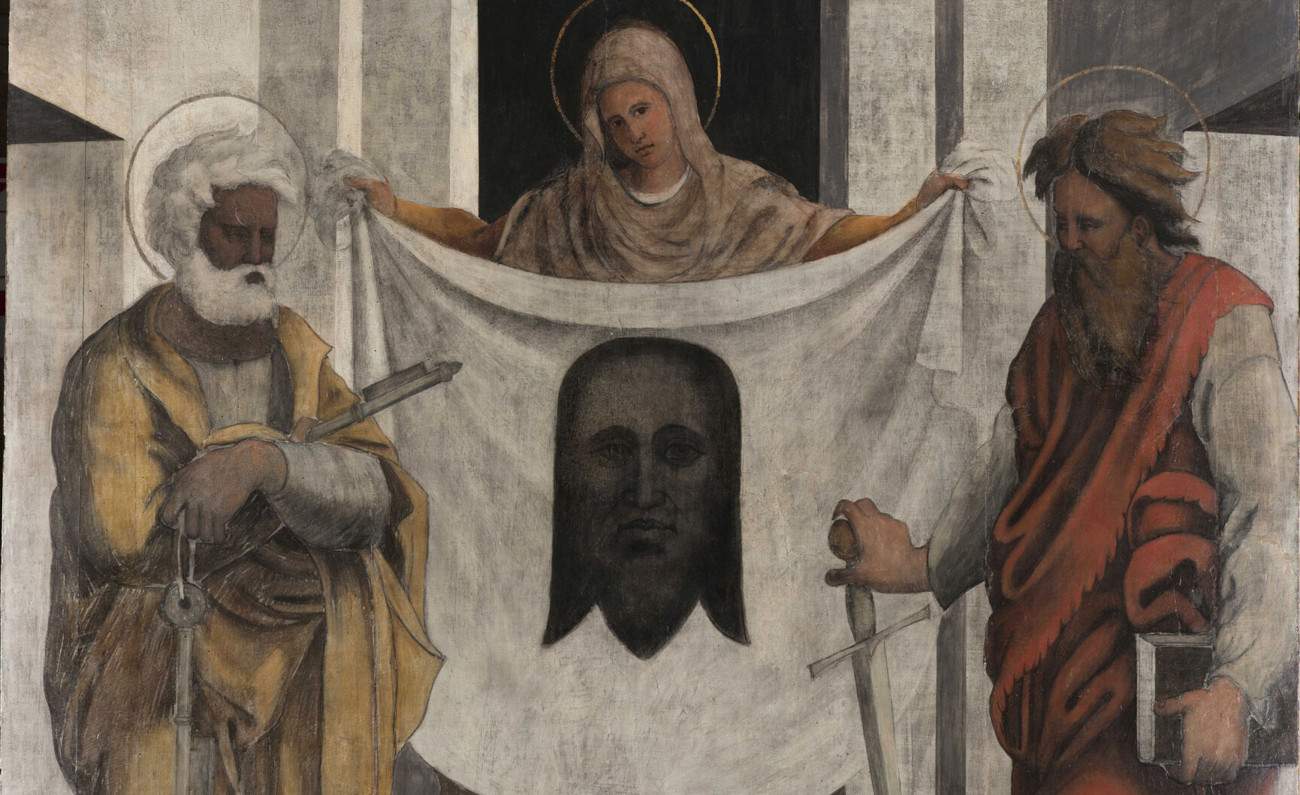For Ugo da Carpi Engraver. The Table of the Holy Face from St. Peter’s in the Vatican is the exhibition that the Museums of Palazzo dei Pio in Carpi dedicate to the engraver Ugo da Carpi (Carpi, 1470 - Rome, 1532). Curated by Manuela Rossi and Pietro Zander, and organized under the patronage of the Fabbrica di San Pietro in Vaticano, as well as the Diocese of Carpi and the Museo Diocesano Tridentino in Trento, with contributions from Fondazione Cassa Risparmio di Carpi and BPER Banca, the exhibition that can be visited from Feb. 24 to June 29, 2024 revolves around the altarpiece that Ugo da Carpi made precisely 500 years ago (1524-2024), in preparation for the Jubilee of 1525.
The panel, a devotional work of great importance, once displayed on the altar of the Holy Face in St. Peter’s, presents the figure of Veronica dressed in a yellow tunic and a purple cloak, standing at the doorway of a door above the third step of a staircase that seems to form a sort of podium. Spreading her arms wide, she clasps in her hands the edges of a shroud on which is imprinted the Holy Face of the Lord Jesus, dark and with the characteristic three-pointed outline of the venerated relic kept for at least thirteen centuries in St. Peter’s Basilica. At his sides stand the apostles Peter, holding the symbolic keys, and Paul, who holds a book with his left hand while leaning on a long sword with his right.
Ugo da Carpi was inspired for this work by the woodcut The Veronica shows the veil of the Holy Face between the apostles Peter and Paul made by Albrecht Dürer in 1510, present in the exhibition and coming from the Civic Museums of Pavia, adapted for the altar of St. Peter’s by Parmigianino, whom the Carpi carver attended in Rome at that very time, on the eve of the Holy Year. Parmigianino not only reworked Dürer’s compositional idea into an almost square format but, diluting in the soft texture of the watercolor drawing the harshness of the woodcut, he also arranged for its translation onto the panel.
Although it did not enjoy great fortune, due to Michelangelo Buonarroti’s critique of it and reported in Giorgio Vasari’s Lives, recent diagnostic analyses by the Vatican Museums have revealed the uniqueness of this work; it is a masterpiece of engraving, produced through multi-matrix printing, of which he was a master. The Veronica also testifies to Ugo da Carpi’s intent to develop an alternative technique to painting, such that would guarantee its multiple reproducibility and retain the advantage of being able to produce it in multiple colors and in large size.
It is the engraving technique that is the key to interpreting and interpreting Ugo da Carpi’s woodcut work, which introduces the exhibition of the Vatican panel.
The exhibition thus analyzes the figure and work of Ugo da Carpi, of whom a portrait executed in the late 18th century by Antonio Montanari, known as Postetta, is presented. It will feature chiaroscuro woodcuts preserved in the Museums of Palazzo dei Pio in Carpi, such as The Death of Ananias, considered to be Ugo da Carpi’s first four-wood engraving, or David slaying Goliath, inspired by works by Raphael, and especially Diogenes, his most famous chiaroscuro, done four hands with Parmigianino.
Significant for delving into the technical subject of woodcut and chiaroscuro is the 16th-century wood engraving, Arboro di frutti della Fortuna by an anonymous author, from the Galleria Estense in Modena, presented alongside the printed sheet, which comes on loan from the Museo Diocesano Tridentino in Trento.
The exhibition is completed by a section devoted to large-scale woodcuts, in which Ugo da Carpi’s work is contextualized in the context of the Venetian market for engraved works that developed around Titian Vecellio’s workshop. The Palazzo dei Pio exhibition features four rarely exhibited examples of this early 16th-century production, including the Sacrifice of Abraham (789 x 1076 mm), engraved by Ugo da Carpi, published by Bernardino Benalio in 1515 and attributed to theinvention of Titian and Domenico Campagnola, and by the same artists the Submersion of Pharaoh’s Army (1220×2200 mm), one of the largest woodcuts ever made, from the collections of the Tridentine Diocesan Museum in Trent. Some of the works in the exhibition have been reproduced in relief drawings, made by the State Tactile Museum “Omero” of Ancona, to allow accessibility to visually impaired and blind people.
For info: http://www.palazzodeipio.it/imusei/
Image: Ugo da Carpi, Ostensione del Volto Santo, detail (1524-1525; Città de Vaticano, Fabbrica di San Pietro). Credit Mallio Falcioni.
 |
| 500 years after the Holy Face altarpiece, the Museums of Palazzo dei Pio dedicate an exhibition to Ugo da Carpi |
Warning: the translation into English of the original Italian article was created using automatic tools. We undertake to review all articles, but we do not guarantee the total absence of inaccuracies in the translation due to the program. You can find the original by clicking on the ITA button. If you find any mistake,please contact us.